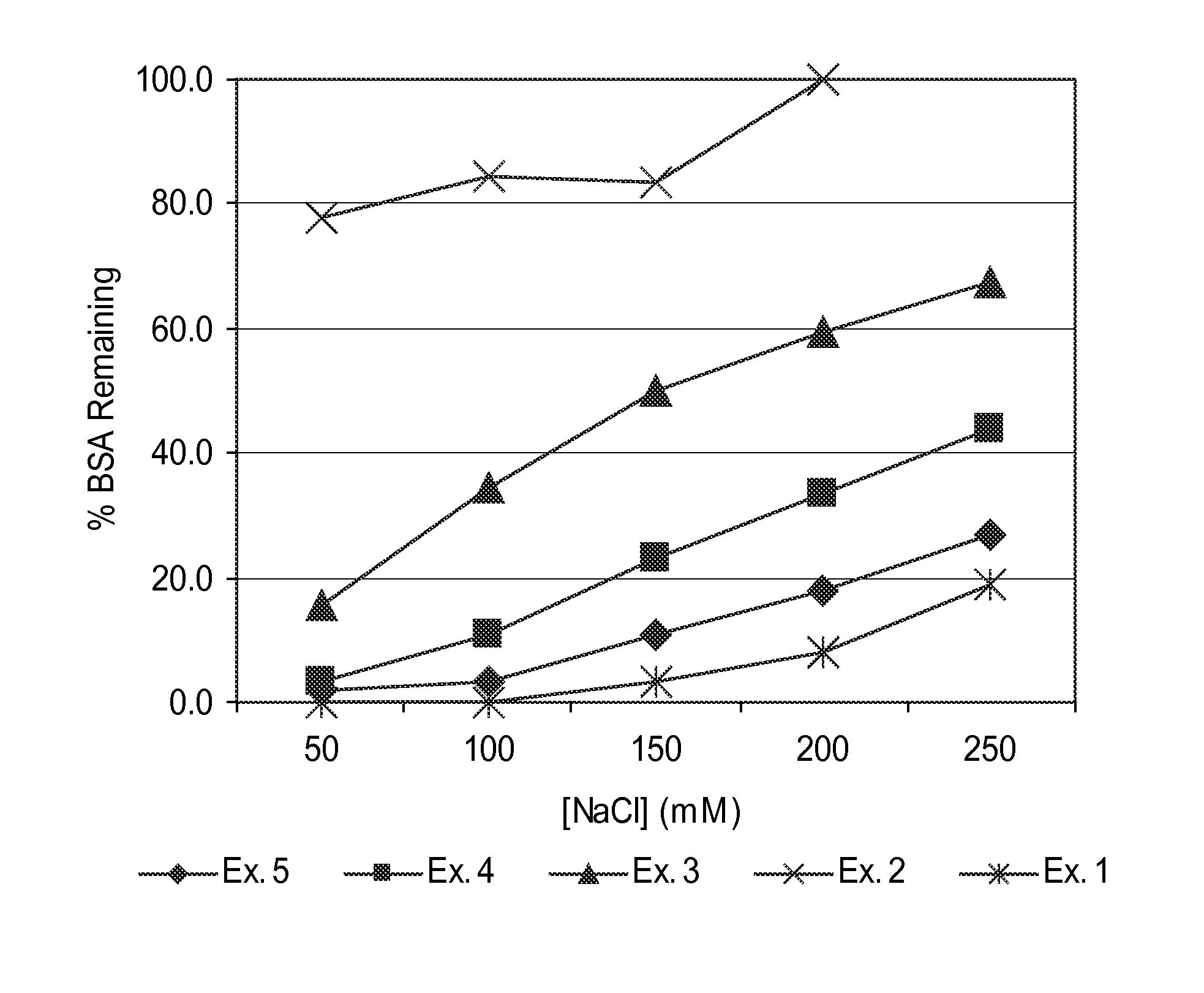Ligand functionalized polymers
a functionalized polymer and ligand technology, applied in the field of ligandfunctionalized polymers, can solve the problems of increasing the occurrence of problematic channeling, severe bottlenecking issues, and low throughput using this technology
- Summary
- Abstract
- Description
- Claims
- Application Information
AI Technical Summary
Benefits of technology
Problems solved by technology
Method used
Image
Examples
examples 1-5
[0103]Diacetone acrylamide (40 grams), ethanol (60 grams) and VAZO 67 (0.2 gram) were charged to an 8 ounce glass bottle. The mixture was purged with a slow stream of nitrogen gas for 5 minutes, sealed, and then tumbled in a water bath equilibrated to 55° C. for 24 hours to convert the monomer to polymer. A portion of this polymer solution (4.07 grams) was diluted with methanol (16.48 grams) and mixed with aminoguanidine hydrochloride (1.08 grams, TCI America, Portland, Oreg.). Trifluoroacetic acid (4 drops) was added as catalyst, and the solution was mixed for 2 hours at ambient temperature. IR and 1H-NMR analyses confirmed the formation of poly(diacetoneacrylamide guanylhydrazone) (polymer 1).
[0104]By similar procedures, polymers 2-5 were prepared by converting 20, 40, 60, and 80% of the repeat units to guanylhydrazone functionality.
examples 6-10
[0105]Copolymers of dimethylacrylamide and diacetoneacrylamide were prepared in methanol solution by the procedure described in Example 1. The copolymers, containing 20, 40, 60, 80 and 0% by weight dimethylacrylamide, were reacted with aminoguanidine by the procedure described in Example 1 except that concentrated hydrochloric acid was used as catalyst instead of trifluoroacetic acid, to produce the corresponding guanylhydrazone copolymers 6-10.
example 11
[0106]Guanylhydrazone polymers 1-5 were assayed for BSA precipitation according to the following procedure. Results are shown in FIG. 1.
[0107]A solution of bovine serum albumin (BSA, Sigma-Aldrich) was prepared in 10 mM MOPS buffer (4-morpholinepropanesulfonic acid), pH 7.5, and determined to have a concentration of BSA of 4.0 mg / mL. A series of BSA solutions were prepared containing various concentrations of sodium chloride according to the following Table 1:
[0108]
TABLE 1[NaCl]BSA5MMOPS(mM,solutionNaClbufferfinal)(mL)(μL)(μL)01005005010100400100102003001501030020020010400100250105000
[0109]Solutions of the polymers from Examples 1-5 were diluted with deionized water to 1% solids by weight and adjusted to pH 7.
[0110]A 5 mL polypropylene centrifuge tube was charged with 2.0 mL of BSA solution, followed by 125 μL of diluted polymer solution. The centrifuge tube was sealed and tumbled end over end for 30 minutes, then centrifuged at 2000 rcf for 10 minutes. A BSA standard solution was p...
PUM
| Property | Measurement | Unit |
|---|---|---|
| wt. % | aaaaa | aaaaa |
| wt. % | aaaaa | aaaaa |
| wt. % | aaaaa | aaaaa |
Abstract
Description
Claims
Application Information
 Login to View More
Login to View More - R&D
- Intellectual Property
- Life Sciences
- Materials
- Tech Scout
- Unparalleled Data Quality
- Higher Quality Content
- 60% Fewer Hallucinations
Browse by: Latest US Patents, China's latest patents, Technical Efficacy Thesaurus, Application Domain, Technology Topic, Popular Technical Reports.
© 2025 PatSnap. All rights reserved.Legal|Privacy policy|Modern Slavery Act Transparency Statement|Sitemap|About US| Contact US: help@patsnap.com



